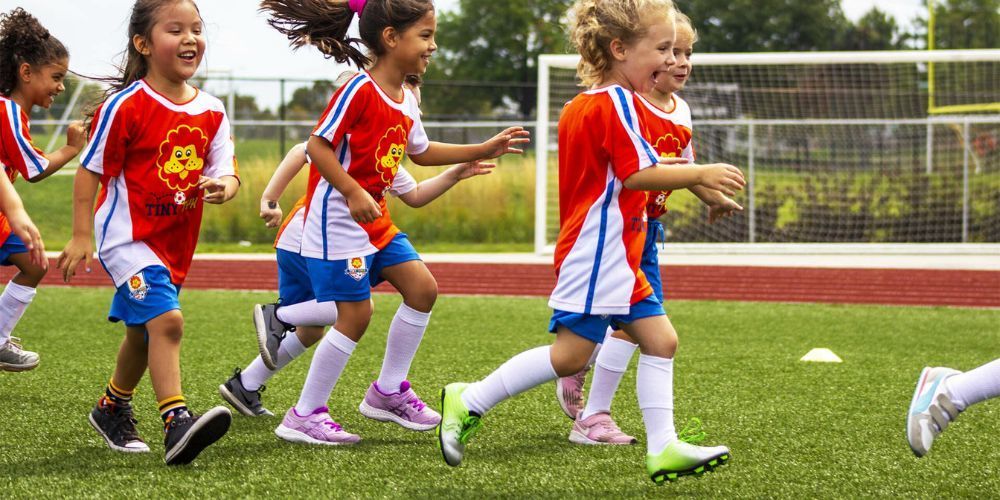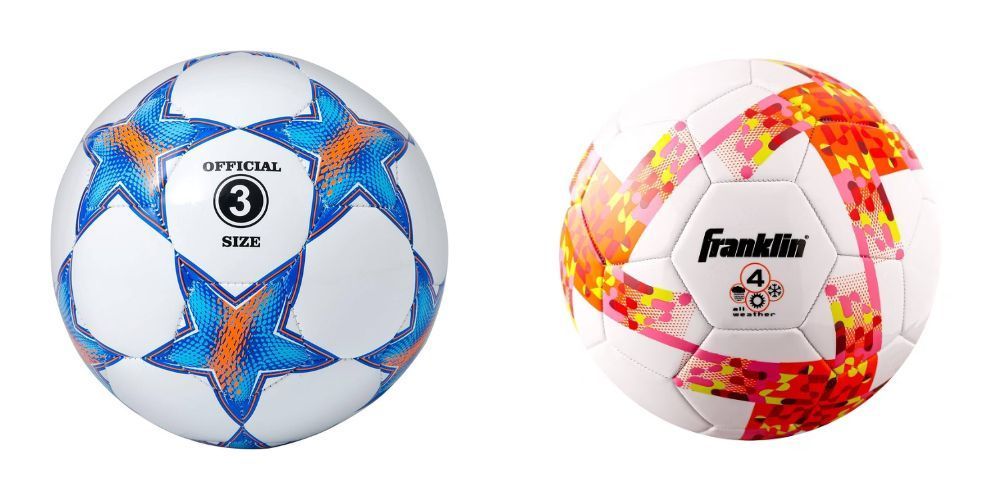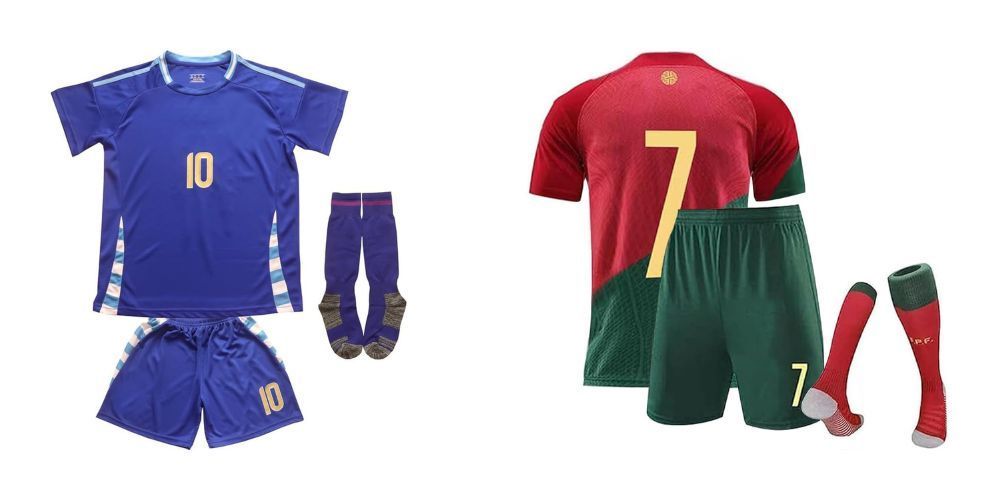Best Soccer Gear for Kids: Top Equipment for Performance and Fun
October 6, 2024
Choosing the best soccer gear for kids isn't just about grabbing what's on sale or picking up what looks flashy; it’s about investing in your child's safety, comfort, and long-term enjoyment of the game. The thrill of seeing them score a goal or confidently defend against an opponent comes from more than just skill—it’s also about having reliable equipment that supports their every move. Lightweight cleats that grip the grass properly can make all the difference in avoiding slips and falls during those rainy weekend matches.
But here's something you might not expect: picking the right soccer ball size isn't just about ease of control; it directly impacts how your child learns to handle passes and avoid unnecessary strain on young muscles. During our extensive research gathering expert insights and real-life reviews from parents like you, we've uncovered key items designed specifically to enhance both performance and fun for budding soccer stars. Let's dive into these must-have gears that every soccer-loving kid needs.
The best soccer gear for kids includes lightweight cleats with good traction and ankle support, properly fitting shin guards for protection, and appropriately sized soccer balls (typically sizes 3 or 4) to help develop their skills. Additionally, quality training equipment such as cones and agility ladders can enhance performance and provide a fun training experience.

Top Soccer Gear for Kids
At the heart of any young athlete's experience is their equipment, which can truly make a difference in both performance and overall enjoyment of the game. For instance, when it comes to cleats, opting for a lightweight option is essential. Brands like Nike and Adidas offer visually appealing designs that incorporate technology enhancing grip and stability. A snug fit around the ankle is vital to prevent injuries as children run, jump, and pivot—activities they will engage in tirelessly during practice and games.
Next in line are soccer balls, where selecting size matters significantly. For kids under 11, sizes 3 and 4 are recommended because they are easier for smaller feet to control and dribble. It's fascinating to watch how a well-fitting ball can boost a young player's agility as they become engrossed in their drills or scrimmage sessions.
When considering shin guards, don't overlook their importance. High-quality shin guards not only protect against impacts but also allow freedom of movement—a key aspect for maintaining comfort during play. An ideal pair fits snugly against a child's shins without being overly cumbersome, allowing them to focus entirely on their game rather than adjusting their gear.
If your child has aspirations of becoming a goalkeeper, securing a reliable set of goalkeeper gloves becomes imperative. Gloves with excellent grip can bolster a young player's confidence as they dive and block shots, enhancing their overall performance. Look for gloves that ensure a secure fit; this combination of comfort and functionality can instill a sense of security as your little athlete stands between the posts.
Each piece of soccer gear serves its purpose—not just in protecting young athletes but also in encouraging their growth in skill and enthusiasm for the sport. By investing time and thought into selecting the right equipment, parents can foster a positive relationship with soccer as their children develop skills needed for safe and enjoyable play.
With such essential equipment firmly in mind, it's equally important to explore how protective gear plays a crucial role in ensuring safety on the field.
Essential Protective Equipment
When it comes to keeping young players safe, ensuring they have the right gear is crucial. At the heart of this protective arsenal are shin guards, which are indeed non-negotiable. They form a barrier between your child's legs and the hard impact of opponent kicks or accidental collisions. Therefore, investing in a pair that is compliant with regulations and fits well will make a significant difference. An ill-fitting shin guard can shift during play, leaving parts of the leg exposed and vulnerable to injury.
The Importance of Shin Guards
According to a study by the National Institute of Health, players with properly fitted shin guards reduce their risk of shin injuries by 75%. This statistic underscores just how vital these pieces of equipment are for maintaining safety on the field. Parents often think about aesthetics when purchasing soccer gear, but prioritizing functionality and protection should always come first. Many coaches emphasize that investing in quality shin guards is as important as choosing the right soccer cleats.
While shin guards are primary, other protective elements also play an essential role in safeguarding young athletes.
Additional Protective Gear
Beyond shin guards, there are several other items worth considering for a well-rounded protective approach. For instance, mouthguards have gained popularity among youth players and are particularly important during aggressive play. They serve as a shield for teeth and help buffer impacts against the jaw, preventing serious dental injuries. A good mouthguard can absorb much of the force caused by contact, which could mean the difference between a chipped tooth and a smile intact.
Goalkeepers require specific equipment tailored to their unique position. Goalkeeper gloves with built-in wrist supports protect against hyperextension while providing grip during saves—a crucial factor during intense gameplay. Similarly, padded shorts and compression wear effectively protect hips and thighs during falls or sliding plays. So whether your child is diving after a ball or taking a tumble while playing defense, this added padding becomes invaluable.
Selecting quality football gear sets the stage for safer play experiences and allows kids to focus on enjoying the game rather than worrying about potential injuries. As we explore further, let's consider some specialized equipment that enhances performance on the field.

Best Soccer Balls and Cleats
The choice of soccer ball and cleats cannot be underestimated in shaping a child’s performance and enjoyment on the field. A quality soccer ball aids in developing kicking skills and instills confidence as children learn to control their movements. For kids under 11, opting for a size 3 or 4 ball is advisable. These sizes are designed to be lighter while being adequately sized to practice footwork, enabling young players to hone their skills effectively without feeling burdened by heavier equipment. Brands such as Select and Wilson stand out for their durable options, specifically crafted with kid-friendly features that balance fun and functionality during playtime.
Meanwhile, selecting the right cleats is just as crucial in providing stability and support during games.
Choosing the Right Soccer Ball
When it comes to picking a ball, it's important to consider not just size but also materials and construction. A ball made with a synthetic cover typically offers better durability against wear from rough surfaces. As children learn the nuances of kick technique, they need equipment that can withstand their enthusiastic play. Always check for quality stitching, as this contributes to a ball's longevity and its ability to retain shape throughout practices and matches.
Just as vital as the soccer ball are the cleats, essential for traction and performance on the field.
Selecting Suitable Cleats
Cleats should fit snugly yet comfortably; if too tight, they can hinder movement; if too loose, they increase the risk of injury. A great example includes
Adidas Predator cleats, which strike an admirable balance between grip and comfort. These cleats feature textured uppers designed to enhance ball control while ensuring good ankle support—an invaluable trait for active young players.
| Brand | Features | Recommended Age |
|---|---|---|
| Nike | Lightweight, ankle support, firm grip | 7-12 |
| Adidas | Good traction, durable, comfortable fit | 5-14 |
| Puma | Affordable, various sizes available | 6-10 |
Each brand brings unique advantages tailored to different player preferences and styles. It’s wise for parents or guardians to involve children in trying on different models so they can find what feels best during movement. Investing in high-quality soccer balls and cleats fosters an enjoyable experience while building fundamental skills that will accompany them throughout their love of the sport.
As we consider primary gear for budding athletes, it's equally important to look at appropriate clothing that enhances performance on the field.
Clothing and Uniforms
Ensuring that your child is comfortable while playing is crucial; it impacts not only their performance but also their willingness to participate. One of the first things to consider is the material of the clothing. Look for moisture-wicking materials because they keep the body dry and help regulate temperature during intense activity. Brands like Under Armour and Nike provide excellent options known for their quality and performance. When kids sweat, they welcome a fabric that pulls moisture away from their skin instead of absorbing it, which can lead to discomfort.
Beyond just moisture control, fit plays a vital role too. It’s essential that uniforms allow for free movement; clothing that's too tight can restrict activity and distract young players from focusing on their game. Kids need to feel confident in what they’re wearing, and a good fit can greatly boost that confidence. Instead of opting for one-size-fits-all garments, seeking out sizes specific to your child's measurements ensures they have enough room to move freely without any hindrances.
Many youth leagues provide
uniforms, but it's wise to consider investing in an extra set of practice jerseys, shorts, and socks. This not only provides your child with gear that can withstand the rigors of practice, but it also allows them to express some individuality on the field. Customizable kits can add a personal touch, whether it’s including their name or favorite number—something that kids often take pride in and contributes positively to team spirit.
| Item | Material | Benefit |
|---|---|---|
| Jersey | Moisture-wicking polyester | Keeps the body dry |
| Shorts | Lightweight fabric | Allows for free movement |
| Socks | Padded with arch support | Increases comfort |
These thoughtful details not only elevate a child's performance but also foster a love for the game. As we continue exploring essential gear, let’s turn our focus toward the equipment designed specifically for skill development and training.
Training Equipment
Training equipment serves as a cornerstone for skill development in young soccer players. Not only does it help in developing essential skills, but it also keeps training sessions engaging and enjoyable. A well-rounded set of equipment can make a significant difference in how children perceive their practice sessions, leading to enhanced motivation and performance over time.
Cones and Agility Ladders
Cones and agility ladders stand out as prime examples of effective training tools. Using cones can enhance footwork skills and improve agility. Coaches often set up various drills that require quick directional shifts, which helps kids learn to maneuver around opponents effectively.
Agility ladders are fantastic for improving coordination and speed. Incorporating these two tools can turn ordinary drills into exciting challenges that aid fundamental skill development while keeping the fun alive.
For instance, setting up a zig-zag cone drill not only builds footwork but also engages kids in friendly competition as they try to beat each other's times.
Portable Goals
Portable goals are another valuable addition to any junior player’s training kit. They allow for flexible practice locations—whether it's a local park or the backyard. With brands like SKLZ and Franklin Sports known for their durable options, parents can find models that withstand regular use without breaking the bank.
These small goals enable young players to work on shooting accuracy from different angles while adding a game-like element to their practice sessions.
Picture this: Kids taking turns shooting on goal with a backdrop of laughter and cheers; it turns practice into playtime and fosters teamwork.
Rebounders
Rebounders deserve a special mention as versatile training tools ideal for solo practice. They simulate passing and shooting scenarios that help young players refine their ball control and technique without requiring a partner. These devices bounce the ball back, allowing kids to continuously challenge themselves while honing their skills.
The effectiveness of rebounders lies in their ability to support independent practice, granting children the chance to train at their own pace while focusing on areas that need improvement.
Think of it like having a personal cheerleader—always ready to return the ball so your child can keep working on those vital shots or passes.
By integrating such equipment into regular training routines, children not only build essential soccer skills but also cultivate an enduring passion for the sport, paving the way for continued growth and enjoyment. As we consider the next steps, it's important to explore what makes certain brands stand out in quality and reputation.

Recommended Brands and Quality
When it comes to outfitting young athletes, brand reputation is crucial because it indicates the quality and longevity of the gear. Choosing reputable brands like Nike, Adidas, and Puma can streamline your decision-making process while providing reliable equipment that withstands the challenges of active play.
Nike
Nike has carved out a niche in soccer gear manufacturing, particularly with their cleats and training apparel. Many parents appreciate Nike’s innovative designs, which combine style with functionality.
An example from a satisfied parent reads: "Nike cleats have been the best for my 10-year-old; they offer great ankle support and last through multiple seasons." This feedback highlights the excellent balance of comfort and durability—two essential factors for young athletes navigating their soccer journeys.
As we transition to discussing Adidas, it's essential to consider how each brand's specific offerings align with various needs in gameplay.
Adidas
While Adidas gear typically falls on the pricier side, many parents assert that this investment pays off due to its durability and performance reliability. The brand's focus on quality materials means that items like jerseys and shin guards not only last longer but also retain their appearance after repeated washes.
One common observation among soccer families is that investing in better gear tends to save money over time because replacements are needed less frequently.
Beyond just cost, consider how well-reviewed products can significantly boost your child’s confidence on the field and enhance overall performance.
As we navigate through these considerations, remember that decisions about gear purchases should also factor in your child's unique needs and playing style rather than focusing solely on brand names.
Puma
Deserving mention is Puma, another notable brand providing high-quality soccer gear tailored for younger players. Parents often speak highly of Puma’s commitment to performance-driven design without breaking the bank.
Much like Nike and Adidas, Puma offers a variety of items—but what stands out is their focus on creating lightweight materials that enable agility and speed on the field.
Investing in well-reviewed and high-quality products from these reputable brands will not only enhance your child's safety and performance but may also ignite a lifelong passion for soccer. It's essential to remember that while brand names carry weight, selecting equipment based on individual growth needs reflects a deep understanding of nurturing young talent in sports.
What are the essential soccer gear items for kids starting out?
When your child is starting soccer, there are a few must-have items. First, soccer cleats are essential for grip and agility on the field, with most leagues requiring them for safety and performance. Second, shin guards protect against injury, especially during tackles or kicks. Socks that cover the shin guards are also important to keep them secure. A size-appropriate soccer ball, typically size 3 or 4 for younger children, is crucial for practice and skill development. Finally, make sure your child has comfortable, breathable soccer jerseys and shorts to keep them cool during games and practices.
How do I choose the right size soccer cleats for my child?
Choosing the correct size soccer cleats for your child is key for both comfort and performance. When selecting cleats, ensure there’s a little space (about a thumb’s width) between the toes and the front of the shoe. Cleats should feel snug but not tight, offering good support without pinching. Have your child try them on with soccer socks, and let them walk and run to check for comfort. Additionally, consider the playing surface (grass or turf), as different cleats are designed for specific field types. Check with your child’s league if they have specific cleat requirements before purchasing.
What are the benefits of using soccer-specific socks and shin guards?
Soccer-specific socks and shin guards provide more than just protection. Shin guards are vital in shielding your child’s legs from injury during tackles or kicks, as the shin is one of the most vulnerable areas. Soccer socks hold these guards securely in place while providing added comfort. The socks are also made with moisture-wicking materials that help keep your child’s feet dry, reducing blisters and discomfort. They’re typically longer to fit over shin guards and are designed to stay in place even during rigorous movement, which helps prevent distractions on the field.
Check out the latest guides on soccer
Author: William Flaiz










